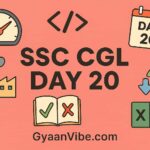GyaanVibe is a focused educational platform dedicated to helping SSC CGL aspirants crack Tier 1 & Tier 2 exam with a strategic, day-wise, and well-structured preparation approach.
SSC CGL Preparation – Day 7
Economy – Inflation and Interest Rates
🧾 1. What is Inflation?
Inflation is the rate at which the general level of prices for goods and services is rising, and, subsequently, the purchasing power of currency is falling.
🔑 Key Terms:
- CPI (Consumer Price Index): Measures retail inflation by tracking prices of essential goods and services.
- WPI (Wholesale Price Index): Measures inflation at the wholesale level, tracking prices before retail sales.
- Core Inflation: Inflation rate excluding food and fuel (volatile items).
- Headline Inflation: Overall inflation including food and fuel.
🔍 2. Causes of Inflation
| Type | Description | Example |
|---|---|---|
| Demand-Pull Inflation | When demand exceeds supply | Festive season rise in product prices |
| Cost-Push Inflation | Rise in input costs (wages, raw materials) | Increase in fuel prices |
| Built-in Inflation | Result of wage-price spiral | Salaries increase → Prices increase |
| Imported Inflation | Due to rise in prices of imported goods | Crude oil price hike globally |
📈 3. Effects of Inflation
- Reduces purchasing power of money
- Affects savers negatively, borrowers benefit
- Hurts fixed income individuals
- Creates uncertainty in the economy
🏛️ 4. Controlling Inflation
The Reserve Bank of India (RBI) uses monetary policy tools to control inflation:
🔧 Monetary Tools:
| Tool | Function |
|---|---|
| Repo Rate | Rate at which RBI lends to commercial banks |
| Reverse Repo Rate | Rate at which RBI borrows from banks |
| CRR (Cash Reserve Ratio) | Percentage of deposits banks must keep with RBI |
| SLR (Statutory Liquidity Ratio) | Minimum reserves in the form of gold/securities |
📌 Tight Monetary Policy (Increasing repo rate) is used to curb inflation.
💸 5. Interest Rates
Interest rate is the cost of borrowing money or return on savings.
🏦 Types of Interest Rates:
- Repo Rate: Lending rate by RBI to banks
- Reverse Repo Rate: Borrowing rate by RBI from banks
- Bank Rate: Long-term borrowing rate by banks from RBI
- Base Rate: Minimum interest rate set by banks
- MSF (Marginal Standing Facility): Overnight borrowing rate by banks
📊 6. Real vs Nominal Interest Rate
- Nominal Interest Rate: Stated rate without adjusting for inflation
- Real Interest Rate: Nominal rate – Inflation rate
For example, if nominal rate = 8% and inflation = 5%, real rate = 3%
🏁 7. RBI’s Inflation Target
- As per Monetary Policy Framework (2016):
- Target Inflation (CPI): 4% with a tolerance band of ±2%
- Range: 2% to 6%
🏦 8. Monetary Policy Committee (MPC)
- Formed under RBI Act, 1934
- 6 members (3 from RBI, 3 nominated by Government)
- Decides key rates (e.g., repo rate)
- Headed by RBI Governor
🔐 9. Inflation Index Bonds (IIB)
- Government securities that protect investors from inflation by linking returns to inflation indexes (like CPI).
🧠 10. Important Current Concepts
- Stagflation: Inflation + Unemployment + Slow growth
- Disinflation: Decline in the rate of inflation (prices still rising, but slowly)
- Deflation: Fall in general price levels (negative inflation)




